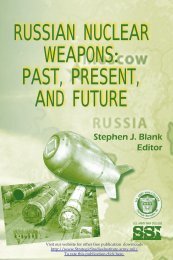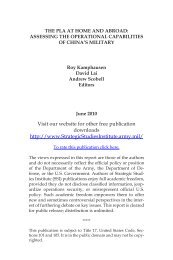Warriors in Peace Operations - Strategic Studies Institute - U.S. Army
Warriors in Peace Operations - Strategic Studies Institute - U.S. Army
Warriors in Peace Operations - Strategic Studies Institute - U.S. Army
You also want an ePaper? Increase the reach of your titles
YUMPU automatically turns print PDFs into web optimized ePapers that Google loves.
not been given a “stop loss” authorization, so we had to<br />
rotate soldiers to replace normal losses. The new<br />
replacements had to be equipped and tra<strong>in</strong>ed prior to<br />
deployment. Because of the limited number of tra<strong>in</strong><strong>in</strong>g<br />
allocations per unit and shortages of some items of issue, it<br />
was a constant battle to get soldiers prepared for<br />
deployment. We were also try<strong>in</strong>g to take a reasonable<br />
approach, and let new soldiers at least get their families<br />
settled <strong>in</strong>to quarters, as we were encourag<strong>in</strong>g them to br<strong>in</strong>g<br />
their families when they moved to Germany. This was<br />
because of the negative impact that fewer and fewer<br />
families would have on the communities of deployed units.<br />
As a result of the difficulties, <strong>in</strong>dividual replacements<br />
were managed at an unbelievably high level. The corps rear<br />
detachment (called Task Force VICTORY) was manag<strong>in</strong>g<br />
down to <strong>in</strong>dividual level. We were send<strong>in</strong>g reports to them<br />
on the particular shoe sizes <strong>in</strong>dividuals needed. This is<br />
exactly opposite to the mission order approach Capta<strong>in</strong><br />
Dave Korty had so successfully executed <strong>in</strong> creat<strong>in</strong>g the<br />
frustrated cargo movement control center. We wasted a lot<br />
of human energy because of this different approach. It<br />
worked, but I believe a more mission-oriented method<br />
would have worked better.<br />
By March, rear detachment operations were smooth<strong>in</strong>g<br />
out, and we began concentrat<strong>in</strong>g on putt<strong>in</strong>g units back<br />
together aga<strong>in</strong>. We could not approach it with a bus<strong>in</strong>essas-usual<br />
attitude. Units had rear detachment-associated<br />
missions, such as guard<strong>in</strong>g <strong>in</strong>stallations, that prevented us<br />
from hav<strong>in</strong>g a normal tra<strong>in</strong><strong>in</strong>g program.<br />
However, we started <strong>in</strong>corporat<strong>in</strong>g tra<strong>in</strong><strong>in</strong>g events <strong>in</strong>to<br />
these missions. One example I recall was mov<strong>in</strong>g some<br />
tanks to Kirchgoens dur<strong>in</strong>g a guard operation so that the<br />
unit could conduct Tank Crew Gunnery Skills Tests while<br />
guard<strong>in</strong>g the <strong>in</strong>stallation. The company commanders were<br />
very creative <strong>in</strong> develop<strong>in</strong>g tra<strong>in</strong><strong>in</strong>g plans to take advantage<br />
of available time.<br />
115
















